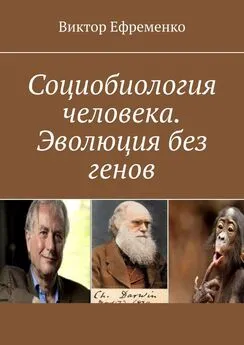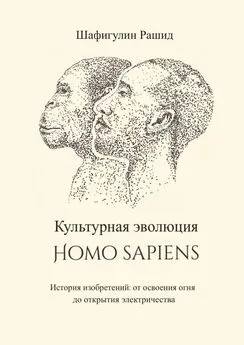Виктор Ефременко - Социобиология человека. Эволюция без генов. Социальная (культурная) эволюция
- Название:Социобиология человека. Эволюция без генов. Социальная (культурная) эволюция
- Автор:
- Жанр:
- Издательство:неизвестно
- Год:неизвестен
- ISBN:9785448516511
- Рейтинг:
- Избранное:Добавить в избранное
-
Отзывы:
-
Ваша оценка:
Виктор Ефременко - Социобиология человека. Эволюция без генов. Социальная (культурная) эволюция краткое содержание
Социобиология человека. Эволюция без генов. Социальная (культурная) эволюция - читать онлайн бесплатно ознакомительный отрывок
Интервал:
Закладка:
Социобиология человека. Эволюция без генов
Социальная (культурная) эволюция
Виктор Андреевич Ефременко
Иллюстратор Виктор Андреевич Ефременко
© Виктор Андреевич Ефременко, 2019
© Виктор Андреевич Ефременко, иллюстрации, 2019
ISBN 978-5-4485-1651-1
Создано в интеллектуальной издательской системе Ridero

Introduction. Cultural evolution
Evolution without genes
The book is devoted to the popular presentation of some questions of the new science of human society – Sociobiology of human.
Sociobiology of human is a system of Sciences, the object of study of which is the species Homo Sapiens, its behavior in societies, selection rules that make societies stable enough, methods of manipulating its behavior, conditions leading to revolutionary changes. Culture should be considered as the result of non-morphological, functional adaptations of the brain Homo Sapiens, changing human behavior in the social environment.
Modern man in the form as we know it, is not created by Darwinian biological evolution alone. This evolution has created species Homo sapiens, which as a result of cultural evolution has become a modern man. The cultural evolution of this species was able to move much further than all other species from the order of primates. In biological evolution in the process of natural selection, a morphology (structure) of organisms changes with the memorization of selected characteristics by fragments of the DNA molecule, genes.
A DNA molecule has the remarkable property of creating its own copies (replicated).
For any evolution of the living, replicators are needed, without which evolution is impossible.
Genes are such replicators for all biological evolution. With the advent of nerve cells, and then the brain in multicellular organisms, they were able to accumulate in it some experience throughout life. Experience in higher mammals plays a big role in their lives. This experience can not be transferred to the next generation by genes, as morphological properties are transmitted. Their own experience, everyone must assimilate himself and the fate of the individual largely depends on the success of this assimilation. The process of remembering in the brain is not a process of changing its structure, it is a change in its functions, i.e. functional transformations.
The book developed and proposed a model of the mechanism of non-genetic inheritance of functional adaptations of the brain, which manifest themselves in human behavior as a change in its mentality.
This mechanism is made up of interactive brain programs called MEMs, that can replicate. This applies to all living beings with the brain. Transfer of skills, knowledge in populations is a well-known fact. However, replication of brain programs is possible only in individuals in the same population. This transfer can be called horizontal. This MEMs as replicators differ from genes that transmit information to subsequent generations of the population, being replicators of the vertical type.
Man stands out from all the representatives of the order of primates in that he managed to create a system of non-genetic inheritance of the experience of previous generations. This actually allowed him to become the dominant species on the planet. The developed language of communication, socialization, sufficient intelligence and, finally, the creation of writing, these are the main factors that made possible the transfer of cultural inheritance (functional adaptations) in a non-genetic way.
The creation of writing should be regarded as the appearance of external memory, which helps to organize cultural inheritance in the human society. MEMs become full-fledged replicators that allow vertical replication. The acquired experience and knowledge can now be easily transferred to subsequent generations.
Traces of human activity throughout the historical period should be seen as a manifestation of its cultural evolution. It is not right to talk about the evolution of culture in itself. Culture is the result of human activity, it is he who evolves in a non-genetic way, and therefore the evolution of his cultural manifestations in society is observed. All other primates who do not have a developed language of communication, especially ways of fixing functional adaptations of the brain with the help of writing, have stopped on the halfway point of cultural evolution.
Sometimes human behavior is suggested to be analyzed on the basis of the laws established by ethology (the science of animal behavior). But this approach does not take into account:
1.That the human mind, its communicative abilities are qualitatively different than in other animals. 2. The degree of socialization of man is also much greater than even in the eusocial communities of ants, bees and other insects from the order of the Hymenoptera. 3. In addition, to draw conclusions about the functioning of a supercomputer based on the study of the device calculator is not entirely correct.
The book details the reasons why a man can not already be considered in the evolutionary plan as a representative of primates within the framework of biological science, and for it, consideration within the framework of sociobiology is required.
Therefore, sociodarvinism, as an attempt to apply exclusively biological regularities to explain human behavior, is untenable.
Eusocial insects belonging to the order of the Hymenoptera, which includes bees, ants, termites in the way of socialization, without much intelligence, also proved to be very successful in biological criteria of reproduction and survival. But they have neither a reasonable mind nor a developed communication language, let alone writing, to create their own adequate human civilization.
About 50 thousand years ago there were about 6 species of anthropoid apes. As a result of natural selection, only one species of Homo sapiens, which appeared about 180,000 years ago in the family of hominids in Africa, has survived from them. This species, which for some time has been called a man, has become the dominant species on the planet.
It differs from other species in that the adaptations acquired by it in the process of evolution are not morphological (strong legs, sharp fangs, etc.) but functional adaptations of the brain. They are not transmitted by genes, but only by brain structures. This evolution is called social or cultural. This is an evolution without genes.
For the first time the idea of replicators of culture was expressed by R. Dawkins. Clinton Richard Dawkins (March 26, 1941) – English ethologist, evolutionary biologist, scientist and popularizer of science. R. Dawkins became famous in 1976, when his book «The Selfish Gene» was published, in which the term «mem» was introduced into the lexicon, denoting a unit of cultural information (analogous to a gene in genetics) copied and transmitted from one carrier to another and subject to mutation, natural selection and artificial selection. According to
R. Dawkins, «meme» is an idea in consciousness. The new view developed in this book is to consider them not as ideas in the mind, but as interactive brain programs that are localized in places of the brain that are inaccessible to consciousness (according to Freud) – in the unconscious or in the subconscious. Therefore, I had to change the spelling of the term on MEM.
Developing the ideas of R. Dawkins, I proposed the term MEMnome, which is the whole set of MEMs of a human, reminiscent of the sounding genome.
It is shown that the mentality of a person is a phenotypic manifestation of the MEMnom, and this is the most important factor determining the course of the historical process. Biological adaptations with the help of genes cause changes in the morphology of individuals, and sociobiological adaptations with the help of brain structures, MEMs refer to changes in mentality. For the species Homo sapiens, they have acquired decisive importance.
At some stage of the evolution of the HS species, when a person himself becomes part of a society, genes seem to delegate their powers to MEMs. How the mutations of MEMs occur, the changing mentality of a person in detail can be understood after the creation of another science, which we conventionally call «Population MEM.»
Unfortunately, at present Genetic determinism, which dominates in biology, tries to imagine everything so that genes control all changes not only in morphology, but also in the social behavior of a person in his mentality. At the same time, biologists are perfectly aware that the acquired signs can not be transmitted by genes to the next generation. They know, but insist that the genes control everything.
Mentality largely determines the behavior of a person, the way he thinks and priorities. Nevertheless, MEMs as replicators are rejected by many biologists, in view of the fact that they do not fit into the formed paradigm of genetics. But in fact 86 billion brain cells (neurons) of a human being for some reason exist. Do not they code our mentality?
The book consists of 3 sections. In the first, well-known positions of the evolutionary theory in biology are considered, which, in my opinion, every person should know and which will be needed to assimilate the principles of sociobiology. In the second, a model of cultural evolution is developed and justified with the help of the concept of MEMs, and the third part is the application of the concept to real social processes and some of the conclusions that follow from this.
Finally, the concepts of socialism and capitalism are discussed from the point of view of sociobiology. Along the way, some considerations are given on the question of the «meaning of life», a term that has unequal significance in different contexts. This is the most polysemantic term most people do not see, and therefore everyone, from their own experience interprets in their own way.
The book is written in an attempt to find some universal approaches for solving problems related to social evolution, i.e. development of human society. The historical process can be regarded as the evolution of a culture understood in a broad sense. At the same time, the ambiguity of the interpretation of its individual elements disappears, as it happens when considering from the humanitarian and philosophical positions. Books on history, often correspond to the prevailing mentality of the authorities.
ВВЕДЕНИЕ
В настоящем третьем издании книги материал существенно переработан с целью дальнейшей систематизации, облегчающей восприятие для неподготовленного читателя. Книга посвящена популярному изложению некоторых вопросов новой науки о человеческом обществе – Социобиологии человека.
Современный человек в том виде, как мы его знаем, не создан одной только Дарвиновской биологической эволюцией. Эта эволюция создала вид Homo sapiens, который в результате культурной эволюции, превратился по существу в другой вид – современного человека, который отличается в культурном плане.
Читать дальшеИнтервал:
Закладка:










